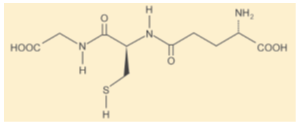Chemical Structure:

Glutathione is a tri-peptide a protein comprised from one amino acid of glutamic acid, cystein & glycine. Glutathione is extremely important cell protectant, manufactured in every cell in the body but is found in highest concentration in the liver, heart & muscle tissue. Glutathione is a very powerful antioxidant and detoxifier that helps maintain cellular health and prevent oxidative stress. The glutathione content modifies livers capacity to detoxify harmful chemicals. Whenever body get expose to the toxins, soon body uses up its supply of Glutathione. Glutathione status is a highly sensitive indicator of cell function. Glutathione deficiency caused by one toxin may render liver vulnerable to other toxins.
Benefits of L-Glutathione in Liver:
• Glutathione is responsible for the biochemical foundation of P450 detoxication in the liver.
• Glutathione controls the survival of hepatocytes during hypoxia through the regulation of mitochondrial generation of oxidative stress.
Other Benefits of L-Glutathione:
• Glutathione is involved in diverse biological processes as protein synthesis, enzyme catalysis, transmembrane transport, receptor action, intermediary metabolism and cell maturation.
• Glutathione provides protection to mitochondria against endogenous oxygen radicals.
 Clinical Evidences
Clinical Evidences
• Critical role of mitochondrial glutathione in the survival of hepatocytes during hypoxia.
Mitochondrial glutathione controls the survival of hepatocytes during hypoxia through the regulations of mitochondrial generation of oxidative stress.
J Biol Chem. 2005 Feb 4;280(5):3224-32
• Glutathione is a systematic protectant against Oxidative and Free Radical Damage.
These data suggest that multi antioxidative treatment in chronic HCV patients is well tolerated and may have a beneficial effect on necroinflammatory variables. A combination of antiviral and antioxidative therapies may enhance the overall response rate of the patients.
Alt Med Rev 1997; 2(3):155-176